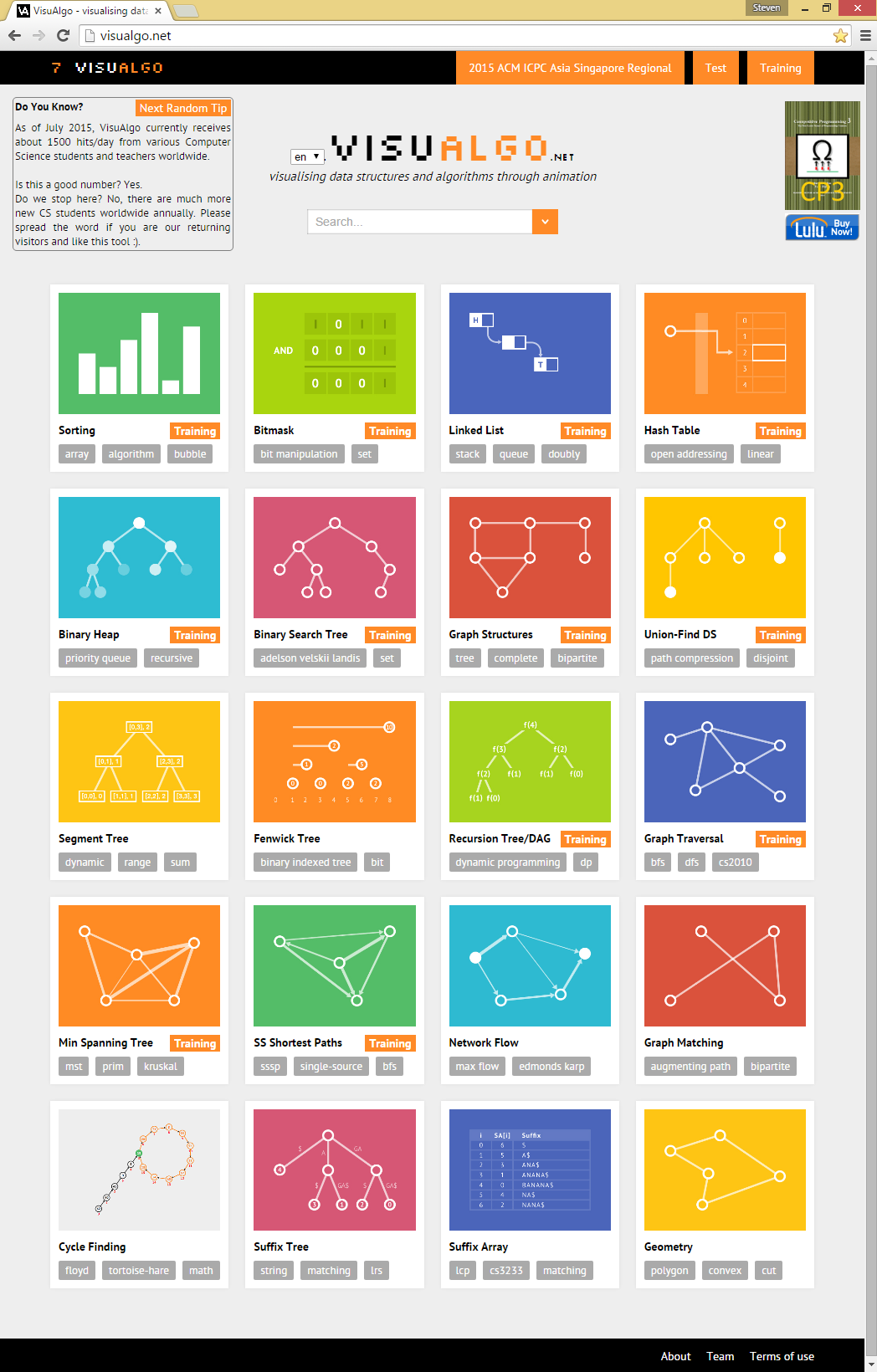CS3226
Web Programming and Applications
Lecture 01 - Introduction
Dr Steven Halim
stevenhalim@gmail.com
Lecture 01 - Introduction
Dr Steven Halim
stevenhalim@gmail.com
Outline
- The People
- Motivation
- Course Administration
The Lecturer (1)
- Dr Steven Halim

- Office: COM2-03-37
Office phone: 6516 7361
Office hour: 10.00am-5.00pm,
not working on weekend :O
Email: stevenhalim (gmail) - V? strong in programming:
NUS ACM ICPC head coach (2008-present)
ACM ICPC Singapore Director (2015, 2018-soon)
Singapore IOI team leader (2009-present)
Singapore IOI 2020 Deputy Chairman
The Lecturer (2)
- Build his first (static) webpage since 2000
 Currently best known as the owner of VisuAlgo
Currently best known as the owner of VisuAlgo
(currently over ~3000 hits per day =)- Continuously learning various recent web programming techniques
The Lab Teaching Assistants (1)
3/4 lab groups (~15 students/group)
Steven + 1/2 Lab TAs

- Steven himself
Lab Group 1, Mon, 10am-12pm
The Lab Teaching Assistants (2)

-
Qua Zi Xian
Took Steven's CS2010/R, CS3233,
CS3226, CS4234 (17 MCs so far)
Lab Group 2, Mon, 12-2pm
The Lab Teaching Assistants (3)

-
Tan Mun Aw
Took Steven's CP3101B
Lab Group 3, Mon, 2-4pm
Lab Group 4, Mon, 4-6pm is closed
Credits
The course material was first created by Arnold Rosenbloom, a visiting lecturer from University of Toronto, Canada who taught the first edition of CP3101B in NUS on Jan-Apr 2014
CP3101B was the old module code of CS3226
The current set of lecture note has been updated three times in Jan-Apr 2015/2016/and now 2017, thus they are now more up-to-date than the forked Arnold's 2014 version
Why do
web programming
(development)?
1. It is (the) current trend
| Previously standalone program or offline | Now available on the web |
|---|---|
| Office softwares | Google Docs |
| Integrated Development Environment | ideone.com |
| Marking of programming assignments | Online Judges, e.g. uHunt*, Kattis |
| Counting Indonesian (presidential) election results | KawalPemilu.org (technical background) |
| Even 3D :O games are making their way to browser | Some demos, this one is cool |
2. More apps are web-dependent
- Google (+other search engines),
- Gmail (+other email servers),
- Facebook (+other social networks),
- Amazon (+other e-commerce sites),
- Dropbox (+other cloud services),
- Grab/Uber/Go-Jek (+other transportation apps),
- NUS IVLE and CORS ,
- ... and this list grows everyday
What is common in no 1-5 of the list above?
3. Hassle-Free*
*Terms and Conditions apply
- No installation*
- Automatic software update*
- 24/7 availability*
4. It Uses Industry Standards
Some* web programming components have well-established standards, e.g. HTTP, HTML5, CSS3, JS (ECMAScript-262)
5. Many of Them are Free* :)
So how the developers survive?
Any drawbacks
of web application?
Unfortunately yes :(...
Some of the drawbacks are...
1. Your web application is generally slower
Why is this so?2. The offline counterparts* are still stronger :O
e.g. The functionalities of Google Slides or this reveal.js are still limited compared to the more established Microsoft PowerPoint
3. Web-apps are more prone to various security attacks
DoS, SQL injection, Clickjacking, stolen passwords,
you name it...
4. Harder to guard intellectual property
It is (very) easy* to look at the "source code"
of the (client-side) web applications
For example, if you want to know how to do this kind of web-based presentation (and replicate it), simply right click this page and click 'View page source'
5. Some tasks become harder
For example, currently a web application (e.g. a web-based image editing software) is not allowed to directly access the host's file system for security reasons
Therefore, the user has to explicitly upload their file(s) to the web server to allow the file(s) to be accessible by the web application
Is learning
web programming
easy?
Unfortunately...
There are some challenges...
1. Too many things to learn...
Other than the current standards of HTML5, CSS3, JS, and a few more, there are many other web technologies out there, each with their own strengths and weaknesses, and this number increases daily, especially the rate of 'new frameworks' appearing here and there...
PS: And once someone is 'imprinted' towards a certain framework (a certain technology stack), it will be super hard to try other framework (technology stack)...
2. It is a moving target...
What is "new" today (e.g. HTML5, CSS3, jQuery 3.1.1, Bootstrap 3.3.7, Laravel 5.3) may be outdated as soon* as this course is over...
We need the ability to learn, relearn, unlearn...
3. More things to be considered...
Compared to offline apps, we have to also consider:
- UI/UX design
- Scalability (one versus many users)
- Various web security issues
- Registering proper domain names
- Cross/old browser compatibility
- Etc
4. Hard to master...
Can your web app generates the intended traffic?
Why don't we just
outsource?
Why don't we just outsource?
Why don't we just
use template?

WordPress, Joomla, WiX, Strikingly, Squarespace, etc
Course Administration
Registration
Via MPE or via CORS
for any :O NUS students who have passed CS1020
Quota: 60 students
It was 57 and 57 in the last two years...
Most likely it is 50 in Sem2 2016/2017
Classes
- Lectures: Every Tuesday, 10am-12pm @ VCRm
- There is no tutorial session
- Lab session: Every Monday, 10am-12pm, 12-2pm, 2-4pm, or
4-6pm@ COM1-B111
Details at CS3226 Lesson Plan
Capstone Project
Details in CS3226 Capstone Project section
The idea is to reserve the last 5 weeks of this course for students to do one medium-sized web programming project in a team setting of 5-6 students with mixed strengths
The capstone projects of CS3226 will be presented to public on the 10th STePS on Wednesday, 12 April 2017 (Week 13)
Textbook?
There is no specific textbook for this course, GIYF*
But you can check these NUS Libraries (or NLB) books:
- Dynamic Web Programming and HTML5,
Paul S. Wang - Programming the World Wide Web (8th ed),
Robert W. Sebesta - Internet and world wide web : how to program,
Paul Deitel, Harvey Deitel, Abbey Deitel - Various JavaScript, jQuery, or jQuery UI textbooks
- Maybe PHP and/or MySQL textbooks
Printing this Lecture Note
You don't have to print these lecture notes (now) as I may update some (minor) parts of it on the spot... :O
But if you are an old-school type, see reveal.js documentation for an easy way to print this lecture note :)
It is best to wait until Theoretical Test on Week11
(open book) before you print these notes
Weightage...
The weightage of various course assessments:
- Capstone project (team): 41%
(using updated "Google PageRank" algorithm), - Theoretical Test: 30%
(written, individual, test everything, Week11), - Lab small deliverables: 6x4 = 24%
(online, subgroups of 2-3 students per lab group), - Lab TA subjective score (individual): 5%
(integer 0-missing, 1/2-silent, 3-the average, or 4/5-active)
Still Not for this semester :O...
Steven has NOT learned these yet (as of early January 2017):
- Various JavaScript libraries other than Vanilla JS and jQuery, e.g. Node.js, AngularJS, etc...
- Various outdated technologies, e.g. Flash, etc...
- Various Server-side technologies other than PHP, e.g. Node.js, ASP(.NET), JSP, Python, Ruby, etc...
- Various Database Management systems other than MySQL, e.g. PostgreSQL, NoSQL like MongoDB, etc...
- Various Web frameworks other than Bootstrap and Laravel, e.g. Ruby on Rails, Django, CodeIgniter, etc...
- Various Website templates: Wordpress, Joomla, Wix, etc...